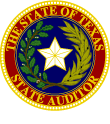
Texas State Auditor
SAO: Reports:
An Audit Report on the Financial Responsibility Verification Program (TexasSure)
 |
John Keel, CPA Texas State Auditor SAO: Reports: An Audit Report on the Financial Responsibility Verification Program (TexasSure) |
November 2009
Report Number 10-016
The Texas Legislature enacted a centralized vehicle insurance verification program known as TexasSure to verify whether owners of motor vehicles have established financial responsibility by obtaining required insurance coverage. TexasSure went online in June 2008 with an automated system containing registered vehicle information that is matched with insurance policy information. As of June 2009, the Texas Department of Insurance (TDI) estimated that 23.22 percent of motorists on Texas roads were uninsured.
Multiple implementing agencies share a role in TexasSure. These include TDI, the Department of Transportation, the Department of Public Safety (DPS), and the Department of Information Resources.
TexasSure has processes and controls in place to accurately retrieve vehicle registration data and personal vehicle insurance policy information. However, TexasSure does not contain complete information on commercial vehicle insurance policies because implementing agencies have not required insurance companies to report that information. As of October 2009, TDI reported that 101,401 commercial vehicles were voluntarily reported to TexasSure, and DPS reported that approximately 83,000 self-insured vehicles were reported to TexasSure. However, auditors could not obtain reliable information for the total number of commercial vehicles in Texas.
For information reported in TexasSure, TDI's subcontractor has automated processes that accurately match insurance policies to registered vehicles in TexasSure 99 percent of the time. TexasSure also communicates with the Texas Law Enforcement Telecommunications System (TLETS) in a secure and reliable manner to provide information on insurance coverage to law enforcement officers.
Although auditors did not identify any instances in which TexasSure data was inappropriately accessed or modified, TDI's contractor should improve its security over motorists' information. For example, the contractor did not properly limit TexasSure access to only those employees with a valid business need. Also, the contractor has not developed formal procedures for modifying TexasSure's program code, performing software upgrades, or conducting general maintenance of computer operations.
To determine how law enforcement agencies (agencies) use TexasSure, auditors surveyed 21 agencies at the city, county, and state level. As of July 2009, 13 of those agencies reported they used TexasSure as a secondary method to determine vehicle insurance information, while 8 agencies did not use TexasSure but planned to use it in the future. The agencies that did not use TexasSure cited a lack of awareness and a lack of funds as the primary reasons for not implementing TexasSure.
Auditors identified opportunities for enhancing the effectiveness of TexasSure to further reduce the number of uninsured vehicles. One of these opportunities includes a recommendation that implementing agencies require motorists to renew a vehicle's registration at a county tax assessor-collector office when the vehicle is identified in TexasSure as uninsured.
Download the Acrobat version of this report. (.pdf)
If you prefer an HTML version, follow this link to an Adobe site which converts PDF files to HTML.